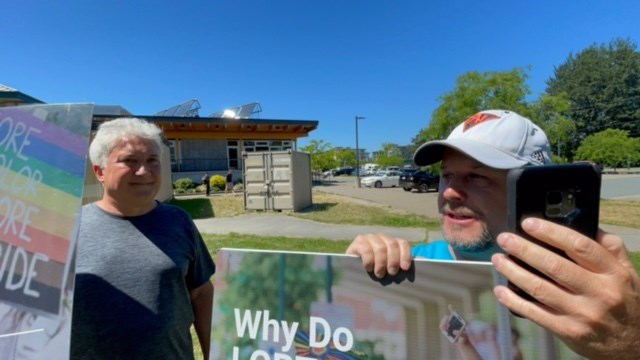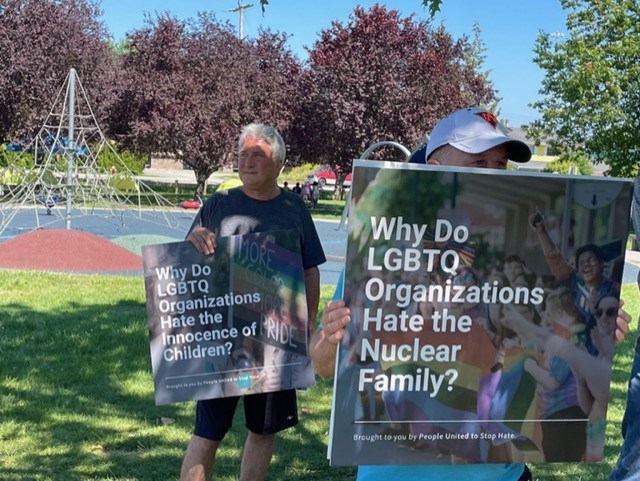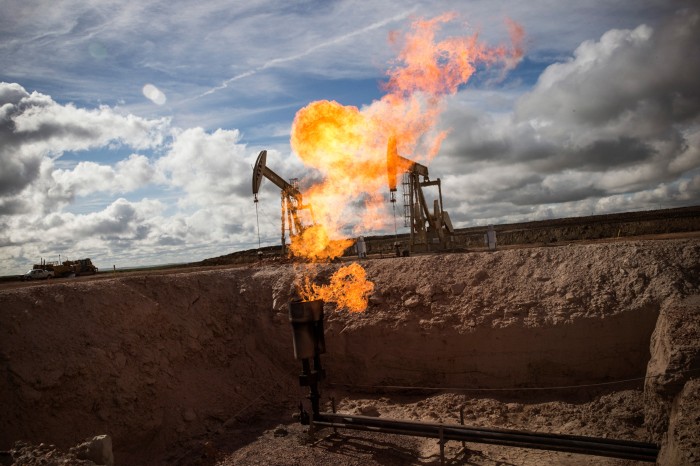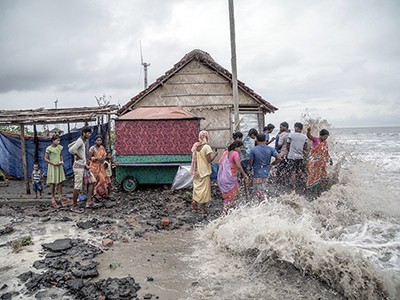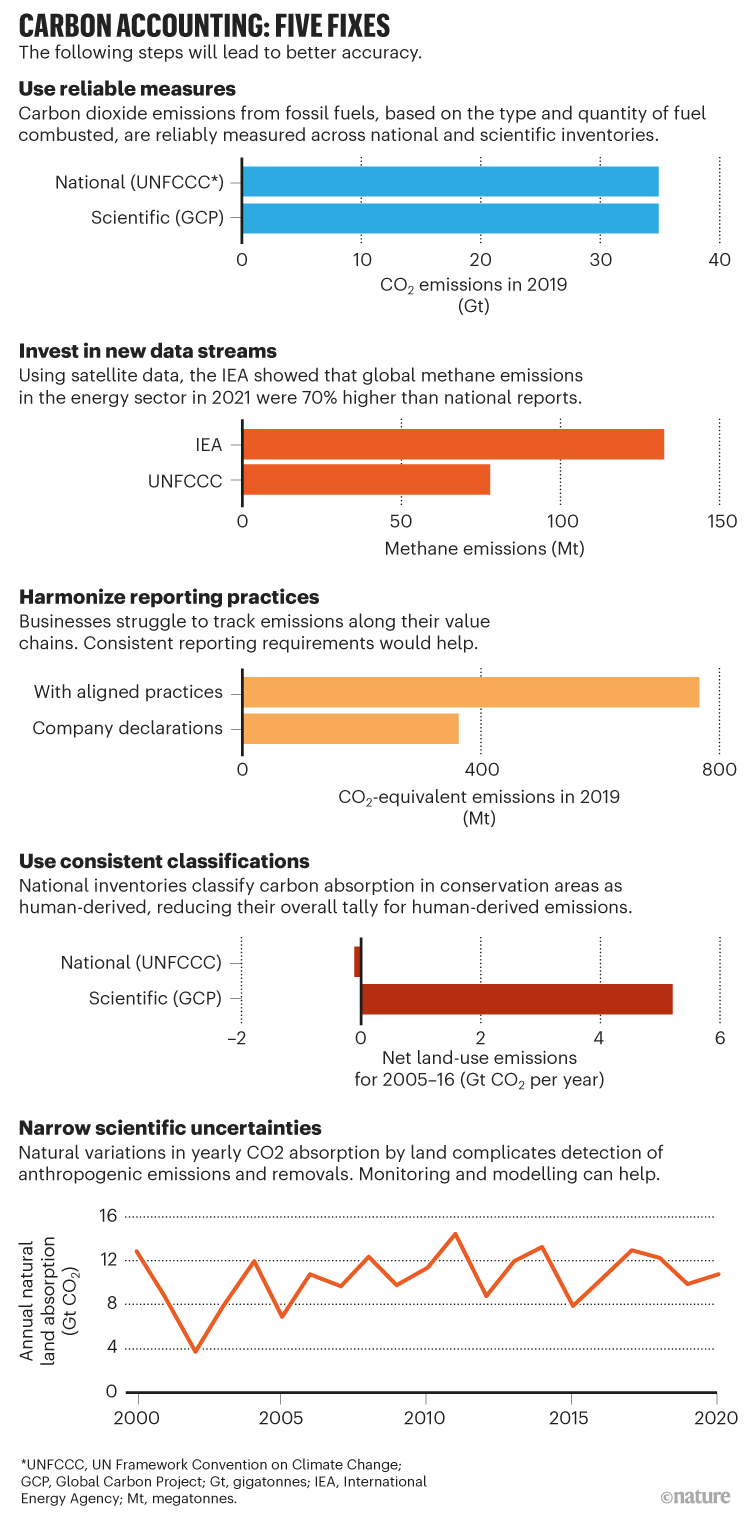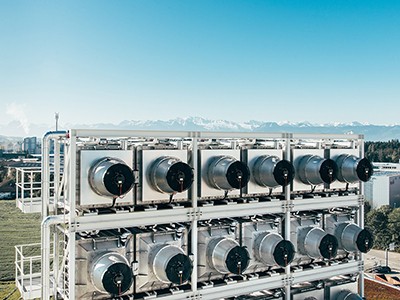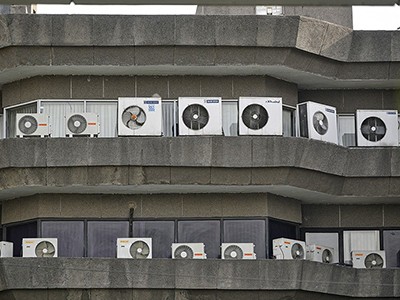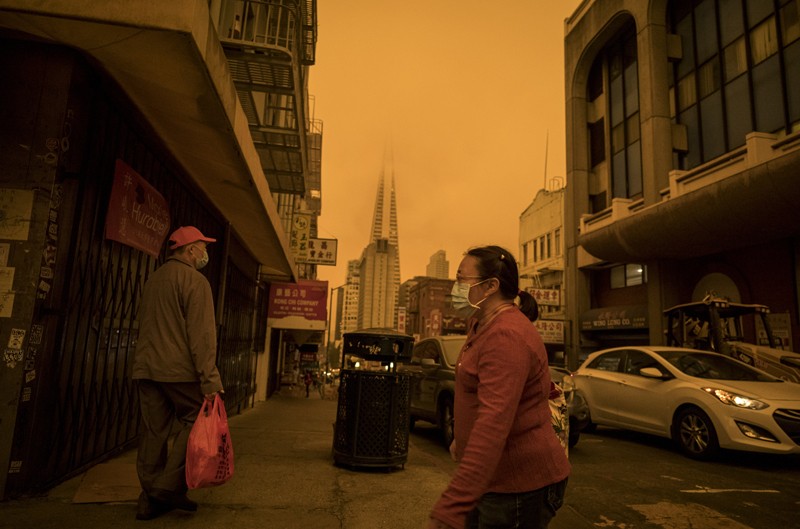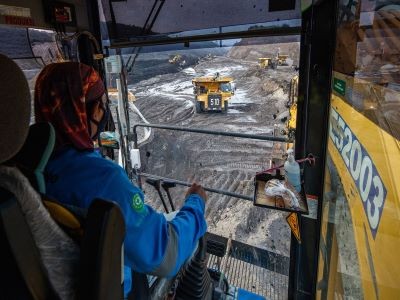A trick of the light is helping scientists turn optical fibres into potential disaster detectors.

Illustration by Lina Müller
Somewhere beneath the Adriatic Sea, a rogue block of the African tectonic plate is burrowing under southern Europe, stretching Italy eastward by a few millimetres each year. On October 26, 2016, the stress triggered an earthquake in the Apennine Mountains, one in a series of quakes which toppled buildings in Italian towns.
On the day of the tremor, Giuseppe Marra, a principal research scientist at the National Physical Laboratory in Teddington, England, was running an experiment that beamed an ultra-stable laser through underground fibre-optic cables. It was part of a larger effort to build one of the world’s most accurate clocks, capable of measuring time to the nearest quintillionth of a second. Almost a thousand miles away from his native Italy, Marra did not feel the quake, but he heard about it on the news. The next morning, he walked to work to review the results of his experiment.
The light of a laser can be studied as a wave, and, as Marra looked at the data on his computer screen, he noticed what he called “a small wiggle” in the oscillations. In the language of physics, the phase had changed. As Marra tried to understand why, he recalled the earthquake, checked the timing, and found that his wiggle occurred at the same time as the squiggles on a British Geological Survey seismogram. In other words, the earthquake had caused a miniscule delay in the arrival of the laser’s light. He calculated that it must have nudged the underground cable by less than a millimetre. Marra had stumbled onto a new way to detect earthquakes.
Scientists have deployed many seismometers on land but relatively few on the seafloor, where the cost of installation is often prohibitive. Yet earthquakes beneath the ocean, and the tsunamis they cause, are some of the most destructive and deadly natural disasters. In 2004, a 9.1-magnitude tremor near Sumatra created a tsunami that killed an estimated two hundred and thirty thousand people. In 2011, a 9.1-magnitude quake near Japan caused a tsunami that killed nearly twenty thousand people and led to the Fukushima nuclear disaster. If scientists could anticipate the movements of tectonic plates, or provide early warning of tsunamis, it would be a major, life-saving advance.
Marra was not the first scientist to consider the earthquake-sensing potential of undersea cables. An older method called Distributed Acoustic Sensing, for example, analyzes the light that reflects off imperfections in glass fibres, and has been used to sense earthquakes and map microfaults. But D.A.S. has a crucial limitation: it can only provide data near the ends of each cable. It doesn’t work in the much longer stretches of cable that rely on repeaters, or cylindrical electronics boxes that boost signals during their journey under the ocean.
More than 1.2 million kilometres of cable—enough to stretch from the Earth to the moon about three times over—crisscross the ocean floor. These cables, which are typically funded by the telecom industry and technology companies such as Facebook and Google, are the hidden infrastructure that make the Internet possible. If scientists could persuade companies to share, Marra’s accidental discovery could allow them to detect earthquakes, in addition to their normal function. “This is not how telecommunications cables are usually meant to work,” Marra said. “But turning them into sensors becomes a possible game changer at the bottom of the sea.”
Scientists know surprisingly little about the inner workings of our planet. The deepest ocean-drilling efforts have collected samples from less than five miles beneath the Pacific. Given the size of the Earth, that’s a bit like poking through the skin of an apple; neither tells you very much about what’s inside.
Earthquakes do something that humans and their instruments cannot: they pass through the crust into the molten center of the planet. As seismic waves move through the crust, mantle, and core, they illuminate the Earth’s structure in roughly the same way that an X-ray illuminates muscle, bone, and cartilage, Zhongwen Zhan, a professor of geophysics at the California Institute of Technology, told me.
The areas where oceanic plates dive beneath continents, known as underwater subduction zones, are particularly mysterious, Zhan said. Many of the worst earthquakes happen there, and the zones often run parallel to densely inhabited coastlines, for hundreds of miles. “We suspect that earthquakes in the ocean are fundamentally different from the ones we have on land,” Zhan said. “Could the plate boundaries be physically different? Is there some kind of different physics there that we don’t know about?”
Some recent studies suggest that plates in subduction zones not only rupture suddenly but can also creep slowly, perhaps over the course of a month, in a way that plates in other zones do not. Seafloor seismometers could measure the creep and map the pressure on different parts of the seafloor, pinpointing the fault zones that are most vulnerable to larger tremors. “If these faults are capable of having smaller earthquakes,” Erin Wirth, a research geophysicist with the U.S. Geological Survey, said, “then they’re also likely capable of having larger earthquakes.”
The problem is that there are so few seafloor seismometers to collect data in subduction zones. “That gives you a very biased view of the interior of the Earth,” Zhan said. “We don’t know how the plates beneath the ocean really behave.” Underwater cables, he added, could change that.
The first transatlantic telegraph cables—the ancestors of today’s fibre-optic technology—were draped across the seafloor in the middle of the nineteenth century. They were the moonshots of their day and collapsed the communication time between Europe and North America from ten days to a few minutes. After the first transmissions, in 1858, the New York Herald declared that “everybody seemed crazy with joy”; the Times worried that rapid communications would prove “superficial, sudden, unsifted, too fast for the truth.” But early cables often short-circuited or were severed by rogue anchors, and the first transatlantic connection lasted only three weeks.
Even then, cables provided an unexpected window into hidden parts of the planet. At the time, naturalists believed that the deep sea was a barren wasteland; based on a fruitless sampling effort in the Aegean Sea, the renowned naturalist Edward Forbes calculated that life could not exist underwater below a depth of about five hundred metres. However, in 1860, an engineer hoisted a broken telegraph cable out of the Mediterranean and found animals affixed to it. The cable had spent two years between Sardinia and Algeria, at a depth of more than two thousand metres. “It really was a turning point,” Helen Rozwadowski, a history professor at the University of Connecticut, said. “The cable was encrusted with life—I mean, there was no way it could have just hopped on.” The discovery reinvigorated deep-sea science and helped inspire pivotal missions such as the Challenger expedition, which discovered thousands of unknown marine species when it circumnavigated the globe in the eighteen-seventies.
In the nineteen-eighties, glass fibres that carried light began to replace copper wires that transmitted electrical pulses. Light has the ability to carry information on many different wavelengths, which are known in the industry as channels. As bandwidth skyrocketed, fibre-optic cables grew into a kind of nervous system for the Internet and its many associated technologies.
“It has always been the case that cables get laid first and then people begin trying to think of new ways to use them,” the sci-fi novelist Neal Stephenson wrote in Wired in 1996. “Once a cable is in place, it tends to be treated not as a technological artifact but almost as if it were some naturally occurring mineral formation that might be exploited in any number of different ways.”
Each cable is roughly the thickness of a garden hose, but it’s mostly a protective sheath around a dozen thin strands of glass, which are so pure that a kilometre-thick block would appear as clear as a freshly washed windshield. Today, about three hundred cables carry ninety-nine per cent of transoceanic data traffic.
Bruce Howe, an oceanographer at the University of Hawaii, has been adding scientific instruments to seafloor cables since the early nineteen-nineties. Telecom companies lay new cables roughly once every quarter century to preëmpt disruptions and incorporate more advanced materials. “Whenever a company decides to turn their cable system off, instead of abandoning it in place, as was done in those days, we thought science could use it,” he told me.
In the late aughts, Howe led the years-long installation of part of the aloha Cabled Observatory, which built on an old AT&T cable situated a hundred kilometres north of Oahu. He and colleagues later wrote that the team struggled to link their instruments to the cable, and the facility struggled to reach its full potential, owing in part to “still-all-too-common cable and connector problems.”
Similar attempts to co-opt mothballed cables also stumbled. In 1998, scientists added a seismometer, a hydrophone, two pressure gauges, and other instruments to an obsolete cable that linked Hawaii and California, but the system failed after just five years. One system near Hawaii developed a short circuit six months after deployment, and another was damaged by fishing activity off the coast of Japan. Commercial hand-me-downs weren’t the way forward.
Howe started to wonder whether it was possible to incorporate scientific equipment into operational telecom cables, which are meticulously maintained by the companies that profit from them. He and his colleagues designed temperature, pressure, and seismology probes that would fit snugly into cable repeaters. “The telecom people were adamant that they wanted nothing to do with us,” Howe told me. As he tells the story, they replied, “No way, because it would affect the reliability of the telecom.” This response disappointed the scientists, who would later estimate that piggybacking on cable infrastructure would give researchers data at a tenth of the cost of building their own system from scratch.
Installing a transatlantic cable takes two to three years and about two hundred million dollars, according to Nigel Bayliff, the C.E.O. of the cable operations firm Aqua Comms. A single repair can cost two million dollars. Any change to a functioning system—even a modest science package added at no cost to the cable company—could become a liability. “It’s a bit like asking for a different toilet on the space station,” Bayliff told me. “It’s, like, ‘Really, guys? Do you really want to risk the whole space station to change the toilet?’ ”
“The only business reason for these cables to exist, as far as we are concerned, is for data connectivity,” Bikash Koley, the vice-president of global networking at Google, which has laid long stretches of cable in partnership with telecom carriers, told me. The company has no intention of adding instruments to its cables, he said.
There are legal obstacles, too. Because seafloor telecom cables are treated as an essential public service, they receive certain freedoms under the United Nations Convention on the Law of the Sea, but the nebulous category of “marine scientific research” does not necessarily receive the same privileges. Bayliff worries about what could happen to telecom projects if they contribute to science.
“Is ninety-per-cent telecom, ten-per-cent science now a science cable?” Bayliff asked. We might not know until a first mover tests the legal waters. But he added that governments might be able to solve this problem by mandating collaboration between companies and researchers. “Once this becomes the norm, then it will just happen all the time and no one will worry, because the risks will all be the same for everybody,” he said.
Howe and his team ultimately collaborated with the government of Portugal, which was planning to replace its aging cable system—and which knows something about offshore earthquakes. In 1755, a massive quake southwest of Lisbon caused a tsunami and devastated the capital. Tens of thousands died.
“They’re motivated,” Howe told me. “They see this in terms not just of telecom operational costs but in human costs, and it may take governments to really balance these kinds of considerations. Companies aren’t going to do that.” The Portuguese government has approved the project, and Howe expects the appropriation of at least a hundred and twenty million euros to happen sometime this year. The cable will connect Lisbon, the Azores, and the island of Madeira; once it’s operational, in 2025, motion, pressure, and temperature sensors in the cable’s repeaters will serve as a seafloor science platform and a tsunami-warning system.
In order for scientists to break the stalemate with the cable industry, they needed ways to use data that already exists, without modifying undersea cables or repeaters. Marra’s serendipitous discovery proved that this was possible.
Then, in 2020, Google agreed to share measurements of light polarization from its fibre-optic network with a scientific team that included Zhan and other researchers from Caltech and the University of L’Aquila, in Italy. Koley told me that Google scientists were happy to collaborate—as long as they didn’t need to add instruments to their cables. “This was a set of data that you would actually throw away otherwise,” Koley said. “It has no other use to us.”
The researchers identified shifts in the polarization that occur when cables bend, twist, and stretch, and cross-referenced the changes with dozens of earthquakes that seismometers detected over a nine-month period. This approach isn’t as sensitive as Marra’s method or D.A.S., but it doesn’t require sophisticated technology in the form of an advanced laser. “Because the method is so easy to implement, we actually now have six or seven cables on board, providing data,” Zhan said.
Last year, Google gave Marra and his team access to a cable-landing station in Southport, England, where the company used a cable that extends to Dublin, and then on to Halifax, Canada. The company was willing to give the researchers temporary access to certain channels when it wasn’t using them. The researchers drove five hours from their laboratory in Teddington and installed customized lasers and detectors, as well as computers that they could access remotely. They now had the power to detect phase shifts beneath the Irish Sea and the Atlantic Ocean.
But they still needed a way to determine where the phase shifts were happening in order to figure out the exact location of seafloor movements. To solve this problem, the researchers took advantage of tiny mirrors that are built into fibre-optic repeaters, which normally help technicians diagnose problems along specific stretches of cable. The hundred and twenty-eight mirrors between Southport and Halifax allowed them to identify the specific portion of cable where a phase shift first occurred. Their approach had the potential to turn the cable into a hundred and twenty-nine localized earthquake detectors.
Marra’s team succeeded in its earthquake-sensing work: they detected and located two tremors. But the experiment didn’t end there. In November, they were reviewing the data on a daily basis and spotted a phase change in the light from the cable beneath the Irish Sea. This time, the signal was different from the earthquakes they had measured before. Marra suspected a different culprit: a cyclone was passing through the area, whipping up waves. The next day, the phase of the light changed even more, and Marra was able to confirm that it closely matched changes in wave height recorded by a nearby buoy. He was amazed that the ocean’s waves had such a direct impact on the light’s waves. “It’s really shouting in your face, the correlation with the wave height,” he told me. “I find that result very beautiful.”
Marra and his team had set out to detect undersea earthquakes, which could hint at where and when a tsunami might form. They ultimately developed a method that could help scientists track actual tsunamis in real time. Marra said that it will take time to analyze the data and separate out the contributions of waves, earthquakes, and other environmental factors. But he envisions a future in which cables could warn coastal communities about the exact location and height of approaching waves. “We’ve got a chance,” he told me. “I’m not sure we had that before.” ♦


